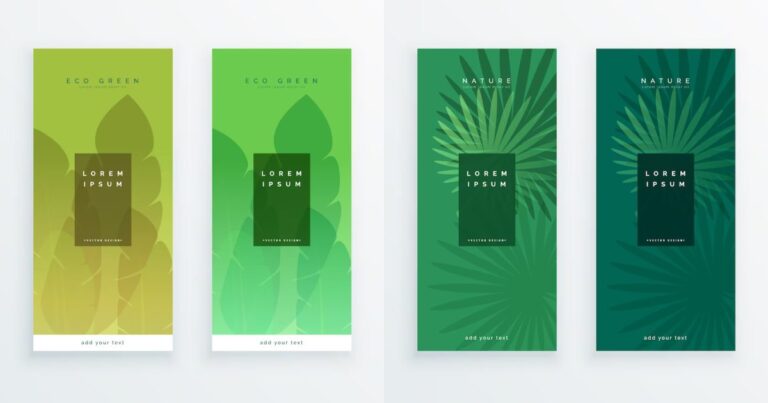As environmental consciousness grows, businesses around the world are exploring sustainable practices not just in their operations but also in their marketing efforts. Among these practices is the use of sustainable banner stands for promoting brand messages.
While participating in marketing, oftentimes the main goal is to spread your message. Not everybody thinks of sustainability however these days you can’t afford not to. It is more crucial than ever before for businesses to be sustainable and socially responsible. Sustainable banner stands are a great start.
So this article explores the environmental impact of traditional banner materials and introduces more sustainable alternatives. We will show you how eco-friendly marketing, also known as green marketing, can improve brand recognition.
As a result, this article will also help your business align with the values of the modern, eco-conscious consumer.
The environmental impact of traditional banner materials
Traditional banner stands should be an act of the past because of the way they impact our planet. To introduce you to some of the impact risks, here are two main aspects of what we fear the most.
The problem with commonly used PVC
The majority of traditional roll-up banners are made from PVC (polyvinyl chloride). In simple terms, it is a type of plastic that is both cheap to produce and highly durable.
However, PVC is a petroleum-based product, the production of which contributes to greenhouse gas emissions. Furthermore, PVC is not biodegradable and is difficult to recycle. So it often ends up in landfills where it can take hundreds of years to decompose.
The hidden costs of metal stands
Metal stands, while more durable and longer-lasting than PVC, are also resource-intensive to produce. Mining and refining the metals used in these stands involve high energy use and environmental degradation.
Additionally, while metals like aluminum can be recycled, this process still requires considerable energy and contributes to greenhouse gas emissions.
Sustainable alternatives for banner stands
Now that we know of the main negatives that surround the commonly used PVC banners, we have some ideas. Some sustainable alternatives that you could consider instead.
Eco-friendly banner materials
Several more sustainable alternatives to PVC banners are available on the market. These include banners made from PE (polyethylene). It is a type of plastic that is recyclable and consumes less energy during production.
There are also banners made from biodegradable materials like cotton, hemp, or jute, which can decompose naturally at the end of their life cycle. What a great deal!
Reusable and recyclable stands
Another alternative is to use reusable stands. For example, some big companies use banner stands made from FSC-certified wood. It is a way better option because this wood is sourced from sustainably managed forests.
Another option is stands made from recycled or recyclable metals. These stands, while still involving some environmental costs in their production, represent a significant improvement over traditional options. It is so due to their potential for reuse and recycling.
The power of eco-friendly marketing
In addition to reducing your business’s environmental footprint, choosing eco-friendly banner stands can have a positive impact on your brand recognition. As we love to state in this blog that company culture is everything, company recognition is another very important aspect.
Helps you align with consumer values
As consumers become increasingly aware of environmental issues, many are choosing to support businesses that align with their values.
By using sustainable banner stands, your business can demonstrate its commitment to environmental stewardship. Thereby you will also automatically attract eco-conscious consumers and improve brand recognition.
Telling your brand’s story
Sustainable banner stands can also become a part of your brand story. They can be used to communicate your commitment to sustainability. It’ll create a powerful narrative that resonates with consumers and sets your brand apart from competitors.
This could include sharing information about the sustainable materials used in your banners or the actions you’ve taken to reduce your environmental impact.
Case studies of sustainable banner usage
Successful implementation of sustainable banners can provide valuable insights. It will be helpful for businesses looking to make a shift towards more eco-friendly marketing materials.
For example, Patagonia, an outdoor clothing and gear brand, is renowned for its commitment to sustainability. The company uses recycled or organic materials for its banners and stands at trade shows and events. This aligns perfectly with their broader business ethos and is a testament to their authenticity, enhancing their reputation among eco-conscious consumers.
Similarly, Lush Cosmetics has been known to use banners made from reclaimed materials in their stores and at events. These initiatives, combined with their commitment to reducing packaging and promoting ethical sourcing, have strengthened their brand image as a leader in sustainability.
Conclusion
Choosing sustainable banner stands is not just a step towards reducing your business’s environmental impact. Remember that it’s also a smart marketing strategy. By aligning your business practices with the values of your customers, you can improve brand recognition and build a strong, positive brand identity.
Eco-friendly marketing is more than just a trend – it’s a reflection of the growing consumer consciousness about the environmental impact of their choices.
And as businesses and consumers continue to understand the urgent need for sustainability, eco-friendly marketing is set to become the new norm. So make sure to adapt sooner rather than later!
Check out our other articles about sustainability topics both in work and at home:
Enjoy!
